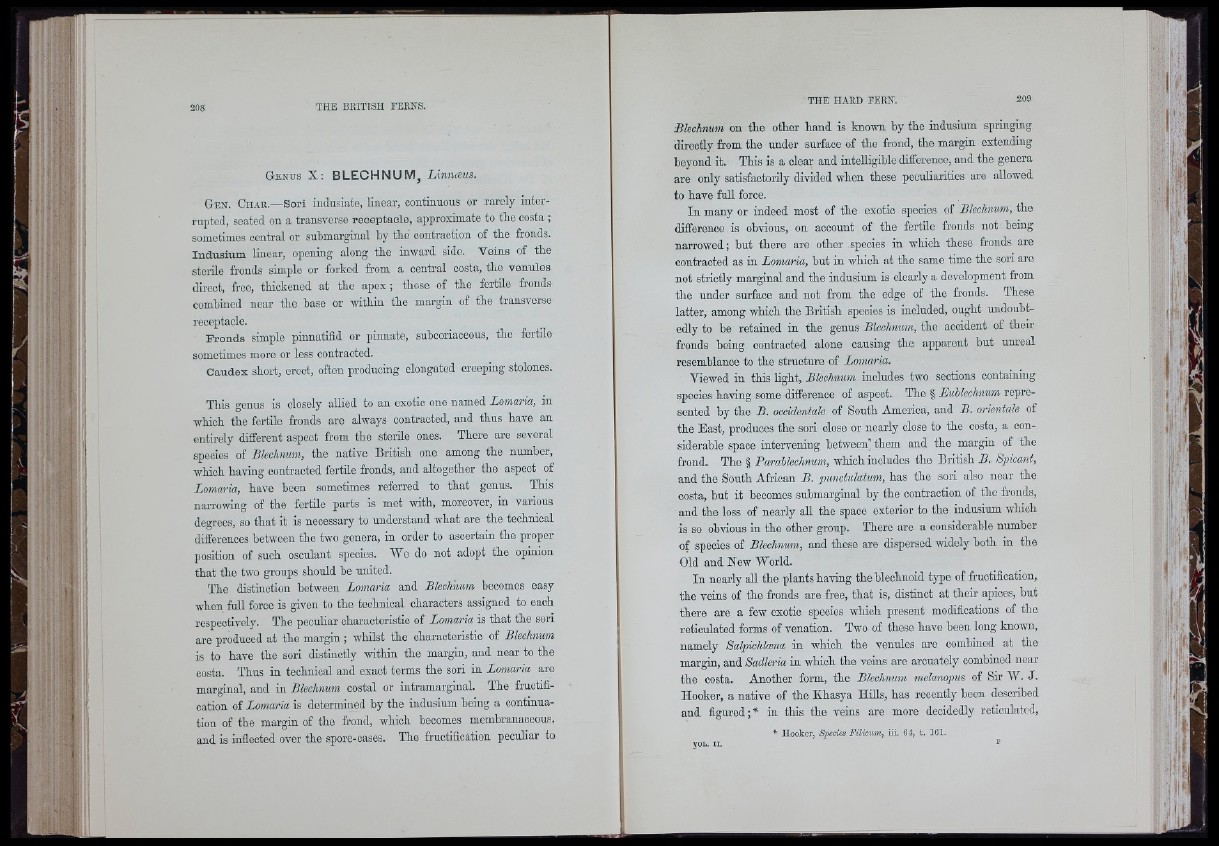
L
!í‘
208 THE BEIT ISH FEENS.
Genus X : B L E C H N U M ^ Linnceus.
Gen. Chak.—Sori indusiate, linear, continuous or rarely interrupted,
seated on a transverse receptacle, approximate to tlie costa ;
sometimes central or submarginal by the contraction of the fronds.
Indusium linear, opening along tbe inward side. Veins of tlie
sterile fronds simple or forked from a central oosta, tbe venules
direct, free, tliiokened at tbe apex ; tliosc of tbe fertile fronds
combined near tbe base or within the margin of the transverse
receptacle.
Fronds simple pinnatifid or pinnate, subooriaoeous, the fertile
sometimes more or less contracted.
Caudex short, erect, often producing elongated creeping stolones.
This genus is closely allied to an exotic one named Lomaría, in
which the fertile fronds are always contracted, and thus have an
entirely different aspect from the sterile ones. There are several
species of Blechnum, the native British one among the number,
which having contracted fertile fronds, and altogether the aspect of
Lomaría, have been sometimes referred to that genus. This
narrowing of the fertile parts is met with, moreover, in various
degrees, so that it is necessary to understand what are the technical
differences between the two genera, in order to ascertain the proper
position of such osculant species. We do not adopt the opinion
that the two groups should be united.
The distinction between Lomaría and Blechnum becomes easy
when full force is given to the technical characters assigned to each
respectively. The peculiar characteristic of Lomaría is that the sori
are produced at the margin ; whilst the characteristic of Blechnum
is to have the sori distinctly within the margin, and near to the
costa. Thus in technical and exact terms the sori in Lomaría aro
marginal, and in Blechnum costal or intramarginal. The fruotification
of Lomaría is determined by the indusium heing a continuation
of the margin of the frond, which beoomcs membranaooous.
and is inflected over the spore-cases. The fruotifioation peculiar to
Blechnum on the other hand is known by the indusium springing
directly from the under surface of the frond, the margin extending
beyond it. This is a clear and intelligiblo difference, and the genera
are only satisfactorily dividod when these peculiarities are allowed
to have full force.
In many or indeed most of the exotic species of Blechnum, tho
difference is obvious, on account of the fertile fronds not being
narrowed ; hut there aro other species in which these fronds are
contracted as in Lomaría, but in which at the same time the sori are
not strictly marginal and the indusium is clearly a development from
the under surface and not from the edge of the fronds. These
latter, among which the British species is included, ought undoubtedly
to be retained in the genus Blechnum, the accident of their
fronds being contracted alone causing the apparent hut unreal
resemblance to the structure of Lomaría.
Viewed in this Kght, Blechnum includes two sections containing
species having some difference of aspect. The § Euhlechnum represented
by the B. occidentale of South America, and B. orientale of
the East, produces the sori close or nearly close to the oosta, a considerable
space intervening between'them and the margin of the
frond. The § Parahlechnum, which includes the British B. Spicant,
and the South African B. punctulatum, has the sori also near the
costa, hut it becomes submarginal by the contraction of the fronds,
and the loss of nearly all the space exterior to the indusium which
is so obvious in the other group. There are a considerable number
of species of Blechnum, and these are dispersed widely both in the
Old and New World.
In nearly all the plants having the bleohnoid type of fructification,
the veins of the fronds are free, that is, distinct at their apices, but
there are a few exotic species which present modifications of the
reticulated forms of venation. Two of these have been long known,
namely Salpichlcena in which the venules are combined at the
margin, and Sadleria in which the veins are arcuately combined near
the costa. Another form, the Blechnum melanopus of Sir W. J.
Hooker, a native of the Khasya Hills, has recently been described
and figured;* in this the veins are more decidedly reticulated,
• Hooker, Species Filicum, iii. 64, t, 161.
Í /«
I :
ill
f:r
ri1
Wk